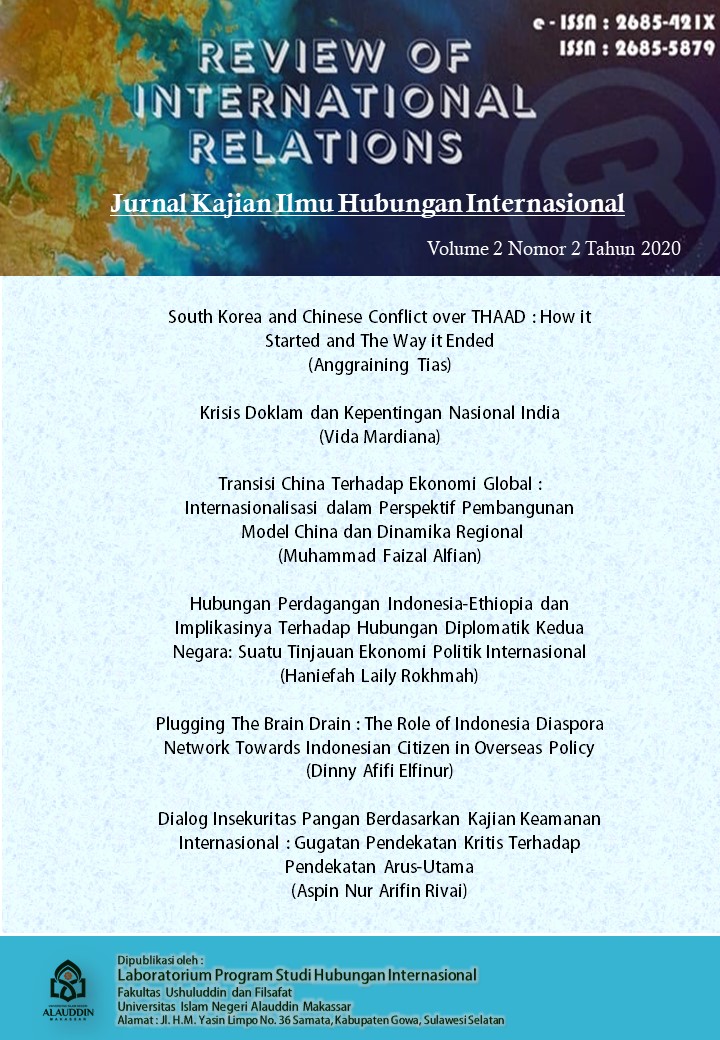Transisi China terhadap Ekonomi Global: Internasionalisasi dalam Perspektif Pembangunan Model China dan Dinamika Regional
Abstract
Pada masa reformasi, faktor ekonomi telah menjadi kekuatan pendorong di belakang pertumbuhan dan pembangunan China. Untuk menjaga keberlangsungan ekonomi secara berkelanjutan, China telah merubah orientasi besar dengan menghadirkan model pembangunan kepada negara lain dengan proyek Belt and Road. Arikel ini bertujuan untuk merumuskan tawaran pembangu Perspektif nan China dengan memaparkan beberapa instrument pembangunannya. Untuk mengamati transisi China terhadap ekonomi global khususnya dalam pembangunan penulis menggunakan pendekatan strategic transition yang diambil berdasarkan kajian terhadap politik luar negeri China. Kemudian penulis menganalisis strategi dengan menerapkan instrument yang digunakan dalam internasionalisasi, serta mengkaji dalam beberapa regional terutama di Asia Tenggara dan Asia Selatan. Berdasarkan analisis data, penulis menemukan bahwa dalam transisi ke dalam ekonomi internasional China telah menggunakan beberapa instrumen yaitu: inisiasi Belt and Road sebagai proyek pembangunan serta instrument lembaga keuangan.
Downloads
References
Addis, A. K. & Zhu, Z. (2018). Criticism of neo-colonialism: clarification of Sino-African Cooperation and its Implication to the West. Journal of Chinese Economic and Business Studies, 16(4), 357-373.
Aoyama, R. (2016). One Belt, One Road: China's New Global Strategy. Journal of Contemporary East Asia Studies, 5(2), 3-22.
Asgarkhani, A., Ghahramani, M. J., & Hajat, M. G. (2019). Geoe-conomic Analysis of China ’ s Foreign Policy. Geopolitics Quarterly, 14(4), 209–233.
Athwal, A. (2008). China India relations territorial imperative. Routledge.
Ayres, A., & Mohan, C. R. (2009). Power Realignment in ASIA: China, India, and the United States. Sage Publications. http://library1.nida.ac.th/termpaper6/sd/2554/19755.pdf.
Blanchard, J. F. dan Flint, C. 2017. ‘The Geopolitics of China’s Maritime Silk Road Initiative’, Geopolitics, .22(2), 223-245.
Brautigam, D. (2010). The Dragon’s Gift: The Real Story of China in Africa. Oxford University Press.
Callahan, W. A. (2016). China’s Asia Dream: The Belt Road Initiative and the new regional order, Asian Journal of Comparative Politics 1(3), 226–243.
Chen, S., & Wolf, C. (2001). China, the United States, and the Global Economy. RAND.
Cheng, J. Y. S. and Zhang W. (2002). Patterns and Dynamics of China's International Strategic Behaviour, Journal of Contemporary China, 11:31, 235-260.
Chung, C.P. (2018). What are the strategic and economic implications for South Asia of China's Maritime Silk Road initiative?, The Pacific Review, 31(3), 315-332.
Dixon, J. (2014). From “Pearls” to “Arrows”: Rethinking the “String of Pearls” Theory of China's Naval Ambitions, Comparative Strategy, 33(4), 389-400.
Freeman, C. P. (2018). China’s ‘regionalism foreign policy’ and China-India relations in South Asia. Contemporary Politics, 24(1), 81-97.
Johnston, A. I. (2013). How New and Assertive Is China’s New Assertiveness?’. International Security, 37(4), 7–48.
Kostecka, D. J. (2011), Places and Bases: The Chinese Navy’s Emerging Support Network in the Indian Ocean. Naval War College Review 64(1).
Khurana, G. S. (2008). China's ‘StringofPearls’ in the Indian Ocean and Its Security Implications, Strategic Analysis, 32(1), 1-39.
Ouyang, L. (2017). One Belt, One Road and China’s Evolution in Foreign Policy and Regional Leadership. In Global Commerce Scholar Thesis.
Pollack, J. D., & Yang, R. H. (1998). In China’s shadow regional perspectives on Chinese foreign policy and military development. In Conference proceedings (Rand Corporation) (pp. ix, 184 p. ;-ix, 184 p. ;). http://library.sfasu.edu/find/Record/818447
Qingguo, J. (2005). Peaceful development: China’s policy of reassurance. Australian Journal of International Affairs, 59(4), 493–507. https://doi.org/10.1080/10357710500367299
Roy, Denny, 2019, Assertive China: Irredentism or Expansionism?, Survival, 61(1), 51-74.
Raman B. (2011), China's Strategic Influence in South Asia, Maritime Affairs. Journal of the National Maritime Foundation of India, 7(2), 134-141.
Sahoo, P. (2013). The Growing Dominance of China in South Asia: An Indian Perspective. The International Trade Journal, 27(2), 111-141.
Swaine, M. D., & Fravel, M. T. (2011). China’s Assertive Behavior Part Two. The Maritime Periphery.pdf. 1, 1–29.
Tiboris, M. (2019). Addressing China’s Rising Influence in Africa. Chicago Council on Global Affairs, May, 1–14.
Trading Economic. (2020). China GDP Annual Growth Rate Forecast. https://tradingeconomics.com/china/gdp-growth-annual
Wagner, C. (2016). The Role of India and China in South Asia. East-West Center: Asia Pacific Bulletin, 40(4), 307–320.
Wang, F. L. (2005). Preservation, prosperity and power: What motivates China’s foreign policy? Journal of Contemporary China, 14(45), 669–694. https://doi.org/10.1080/10670560500206033.
Wilson, J. D. (2017). International resource politics in the Asia-Pacific: The political economy of conflict and cooperation. In International Resource Politics in the Asia-Pacific: The Political Economy of Conflict and Cooperation (Vol. 1). https://doi.org/10.4337/9781786438478.
Yu, H. (2017). ‘Motivation behind China’s One Belt, One Road Initiatives and Establishment of the Asian Infrastructure Investment Bank’, Journal of Contemporary China, 26(105), .353-368.
Zhang, J. (2015). China’s new foreign policy under xi jinping: Towards ‘peaceful rise 2.0’? Global Change, Peace and Security, 27(1), 5–19. https://doi.org/10.1080/14781158.2015.993958.
Copyright (c) 2021 Review of International Relations

This work is licensed under a Creative Commons Attribution-ShareAlike 4.0 International License.










